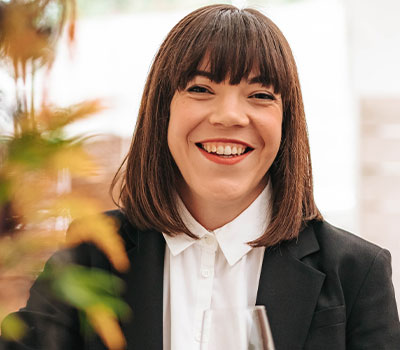Marianna Caldwell is the General Manager and sommelier at Cassia, a James Beard Award semi-finalist in 2023 for Outstanding Restaurant, featuring Southeast Asian cuisine. There are currently 184 wines on Cassia’s list, which Caldwell divides into sections titled “What I’m Drinking Now”—a compilation of Champagne grower-producers and wines from lesser-known regions like the Jura, France and Valais, Switzerland—and “What I’m Always Drinking… (Hint, It’s Riesling)” of her 31 favorites from dry Grosse Gewächs to sweet Auslese. —Alissa Bica


You noted on your survey that wine sales have increased this year.
Yes. Cocktails are still beating us but it’s more balanced—almost even, whereas last year it was still super cocktail-heavy. I have a section in the front of my menu titled “What I’m Drinking,” showcasing bottles that I find particularly interesting or unique, which is fun because people will order off that. I also increased how many actual physical wine lists I have so we can give one out with every reservation [rather than just offering a link through a QR code]. That has really increased wine sales. I’ve noticed, though, that “Dry January” was a real thing. A lot of people were participating in that.
What have you noticed about the wines people have been ordering?
I noticed that some people now know what riesling is. Maybe they’ve heard it’s good; but there’s still also this, “Ooh, maybe, I don’t know,” from others. Dry riesling is predominantly what I sell, and newcomers think it’s going to be sweet and don’t want that, which is tough. I’ve been able to get people into more of the half-dry, halbtrocken, so it’s still about teaching people and helping them navigate. If I want to get someone into Kabinett or something with more residual sugar, I’ll kind of trick them into it by sending the prawns (which are spicy) to the table before the wine hits.
I also have quite a few regulars who come in and ask me to pick a bottle so I can introduce them to something they’ve never had before. I have more whites on my list than reds—people still want cabernet, so I have to navigate that—but white is still the most ordered.
You noted that 85% of your list is composed of little-known grapes and regions. Would you put riesling in that category?
Yes. Because my goal is to have a riesling from every part of the world. I still have some places that are missing, like Australia, but I have riesling from Itata—I’m about to bring in a Slovakian riesling—to try to show that this is a grape that grows in a lot of different places even though it’s a tricky grape to grow. I also want to have varieties that no one has ever heard of so I’m introducing people to new things.
Your staff got excited about the Weingut Aldinger Württemberg Untertürkheimer Gips Riesling Trocken. Why is that?
(Laughs) Mostly because they love saying Untertürkheimer Gips. And they love to do it in a German accent. It’s kind of an easy sell—it’s from Württemberg, it’s really dry, very mineral—for anyone who likes Sancerre, it’s an easy shift. I try to always have benchmark wines like that in every category on the list so servers feel comfortable with them; if I can’t get to the table, they have a go-to. We just sold our last bottle—I was so upset. There was a contest between the servers to see who would sell it. I’m going to wait to bring it back in until they’ve moved through some other things on the list.
Chavy-Chouet La Taupe was another staff favorite.
Yes. It’s just a classic Bourgogne. They’re based around Volnay, so it’s got great, bright red cherry, plum—it’s a fruitier Burgundy for New World palates, and an easy hand-sell at s $78 on the list, which is a nice price-point.
Your best new success was the Manuel Moldes Rías Baixas A Capela de Aios Albariño.
That producer is incredible. The wine is super-complex, lots of texture, a great alternative for sauvignon blanc drinkers. It’s funny. People throw “Sancerre” around as an adjective. I actually think a lot of Sancerre is not good, so they get introduced to wines that I think are better. It’s fun so see people go, “Oh, wow. This is the one.” I had a woman ask for Sancerre, and I told her I didn’t have it but did have a sauvignon blanc from the Loire. I poured her a taste, and she said, “Oh. It’s kind of fruity.” It was one of those moments that I didn’t know what to say. I said, “Well. It is made from grapes.” But as the climate is getting warmer, I’m finding that I prefer albariño to sauvignon blanc as a food-pairing wine.
Have you run into any supply issues this year?
This year, it felt like my import offers all hit in December, so I had to bring in a ton of things then, handcuffing me to a couple wines for a while. I had been told the wines were going to come in October [but didn’t], so I was really lean until they all hit at once.
I also think climate change is becoming an issue. With the Chavy-Chouet, I grabbed the last six cases. Finding good-value Burgundy is like finding a needle in a haystack right now. The 2020 and 2021 vintages are very hard to get, which is why I’m finding myself in places like Spain that offer cheaper, really good-quality wines that are still in the medium-to-light bodied category.
Are prices rising because of that?
Every restaurant is raising beverage prices because that’s where you make the most margin, but food is what has gotten really expensive. I know on the beverage side we’ve had to help the back-of-house, offsetting their higher food costs by lowering ours as much as possible. And people will pay $20 for a chardonnay. If you think about seven or eight years ago, that would have been insane, even at a high-end steakhouse. I may have had one pour in the high teens. Now our average by-the-glass price is $16-$17, and our highest is $20. I’m pretty old-school with pricing on my wine list, but I’m starting to see some trendier places in LA with almost a five-time markup.
Any other trends you noticed with wine this past year?
People are interested in older wines. Especially with riesling, I’ve been working to find older options, so people have that experience. Burgundy—any time I put on an older vintage, it sells out, which is tough because they’re hard to find. I’m trying to ration as much as I can; I’ll keep some down in the cellar for quite a while, especially something like a 2013 Burgundy that is a cool vintage with high acid. I had an older vintage of López de Heredia Blanco priced reasonably, and a guest actually pointed it out to me saying, “This is insane that you’re selling it for this!”
Skin contact continues to be a trend—and natural wines. Although, I think people are starting to get more savvy about what that means. I’ve had a couple guests that say, “I want a natural wine, but I don’t want it to taste like a dead rat.” (Laughs) I’m like, “Yeah! Agreed!” Because that’s called a flawed wine. Most of what I have on the list is what I consider natural, which is minimal intervention, organic and biodynamic. People are starting to understand that there really isn’t a definition for natural wine, you kind of make your own definition—which is why I always ask, “What does that mean to you?” Because if people say they don’t want any added sulfur, I don’t have any wines on my list that fit that category. When people tell me they are allergic to sulfites, I think, “Well, you can’t have wine.” (Laughs) But that’s happening less often.
Based in Los Angeles, California, Alissa Bica is the Associate Editor and Spirits Critic at Wine & Spirits. She is also a sommelier at 71 Above and co-runs the home wine tasting company, Côte Brune and Blonde. In any rare moments of free time, she writes about obscure grape varieties in the blog Off the Beaten Wine Path.
This is a W&S web exclusive. Get access to all of our feature stories by signing up today.


















